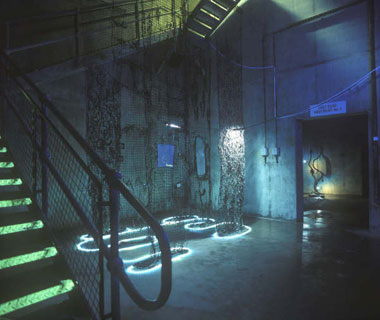 |
| Samantha McKee: The Preserves of the Mind’s Larder , 2005, installation shot; courtesy the artist |
The exhibition consists of two three- and one two-dimensional installation, each in its own room: Budding thoughts…nails in your coffin, The wall of thoughts – states of mind and Scroll 1 and 2. Connecting them is the subject matter and ambient music composed by Thomas Conyngham. McKee wrote to me: “It is important to me that reference is made to the music as it is an equal part of the exhibition and it was a collaboration."
In my perception the sound effortlessly became part of the visual experience, almost unnoticed at times, both holding its identity and fusing with the otherness of the sculptures, drawings and words. Remembering when I encountered something similar, a memory of the 1990 Venice Biennale surfaced with the name of the Venezuelan composer of electronic music, Miguel Angel Noya. Then and there he organised a concert called Horizons of the possible, which he thought of as fusing architecture and music. The sources for the work were taken from the sound generated by the city, by buildings, with the ambition to energize a space, and act as a catalyst for the audience in the presence of sculptures and paintings. Some compared his music to coloured silence.
Conyngham embraced the presence of music as a catalyst for colonizing space too. The sound does not interfere or take over; it only gently opens the fluency of our perceptions.
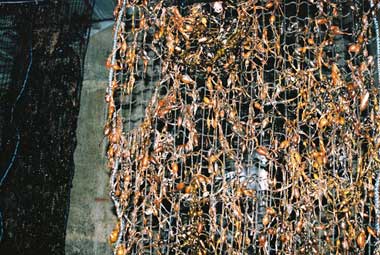 |
| Samantha McKee: The wall of thoughts (detail), 2005; courtesy the artist |
For some years now, McKee has focused on a subject central to all of us: how the brain works, what makes it work better, and what arrests some of its functions. In all three parts, but most strongly in The wall of thoughts, she embedded the terrorizing power of decaying neurons.
I recall, when diagnosed with a serious illness, that I read and searched, read and searched on the subject, in the hope that the knowledge would help me to stop or even reverse the condition. I also recall how my oncologist was impatient with my questions born out of that search. It is conceivable that most of us only attend to an issue when it becomes our problem. McKee deals with the wider issues of science, physicians, society’s drives and aspirations, connecting her personal insights and interests with what is hoped to be an aesthetic experience for others. With some delight she mentioned to me a child’s remark in front of her work: “It looks like my father’s brain, with holes in it."
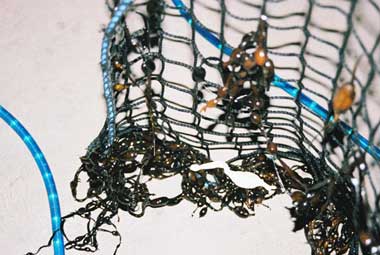 |
| Samantha McKee: The wall of thoughts (detail), 2005; courtesy the artist |
Whether playful or just born out of fragmented knowledge of a brain’s disease, her insights support the hope for aesthetic experience by others . The image of neurons, healthy and decaying, is the work’s dominant theme. The forms are images forged by imagination and nourished by scientific illustrations, made available through imaging tools.
The tenor of the visual rests on a metaphor linking the natural world outside the mind with the pathways of the brain. The artist takes as a metaphor the similarity between the brain’s connectivity, both conscious and not, and seaweed, which she collects, strips to the ‘paths’ and ‘nodes’, varnishes, and weaves into nets. A set of eight of these she calls The wall of thought, “…when an accumulation of neurons filled the cavities in your head." Joining concept and craft, allowing kind helpers to assist her, she still needs months to produce one of the ‘nets’.
Each of the eight nets in the middle room carries a different configuration, some more empty, some more full. The seaweed looks like modules, abaci, viruses, dots-on-lines. Mark Francis produced a similar image in his Thallophyte, 1999, a painting of black dots on black curves over orange-brown curves and an orange ground (exhibited in Milton Keynes Gallery, January – March 2000). 1
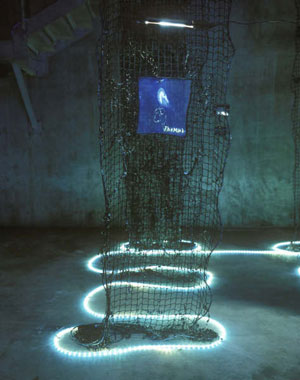 |
| Samantha McKee: The Preserves of the Mind’s Larder , 2005, installation shot; courtesy the artist |
While the three free-standing tubular sculptures with electric bulbs, with a subtitle a nail in your coffin, merge attraction and aversion, they never stop being disconcerting. Neither real nor unreal but imagined doubts and uncertainties tax the rules of statics to the extreme. Such extreme angles one saw years ago in David Smith’s welded sculptures, and more recently in Richard Serra’s rusty steel curves like Torqued elipses (1997) and Switch (1999), inter alia. This comparison between the established masters and the young artist has its roots in the experience of tension and fear forged by a perfect yet tenacious balancing of matter. McKee’s sculptures are small and lean and fiercely loyal to the governing metaphor.
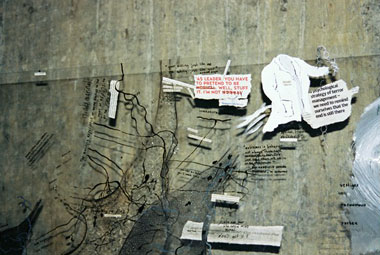 |
| Samantha McKee: The scrolls (1 and 2) (detail), 2005; courtesy the artist |
The scrolls (1 and 2) are set away from the wall, horizontally, casting the shadows of drawings and writings onto it. The blobs are similar to the shapes of neurons obtained by PET and MRI scans. The words, mostly written, sometimes cut out from the printed page and glued in place, rehearse some of the strategies made famous by Jenny Holzer’s Truisms (1977). Here are some of McKee’s words on that wall:
Harsh memories, harsher realities… now that the sense of panic and dread subsided what doesn’t kill you makes you stronger… it is a dense matrix of interconnection bulging mind,,, no more than fragments… whole circuits broke down… The memory comes back in another form – H. Hodgkin, artist… feeding this rather dreary and monochromatic existence… as the brain re-assembles itself… for them happiness was being the same… we need to remind ourselves that the end is still there…
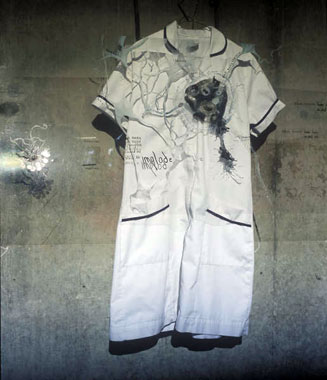 |
| Samantha McKee: The scrolls (1 and 2) (detail), 2005; courtesy the artist |
The installation under the Lagan Weir elaborates the subject matter presented already at four of her previous exhibitions, the last one Sizing thoughts at Golden Thread Gallery, 2004. The use of seaweed in both is so markedly different that it alone indicates with clarity the development of McKee’s art practice: earlier, the material was piled up into a spherical heap, as a dark matter, black hole, something amorphous and so ambiguous that it lost its power to do anything other than flop on the ground. Here, the eloquent forms, drawn, bent or woven, address the subject of the brain’s connectivity, its health and decay, in a focused, urgent manner, as indeed it is a matter of life and death, even if death is resolutely kept out of the picture, if not out of our thoughts.
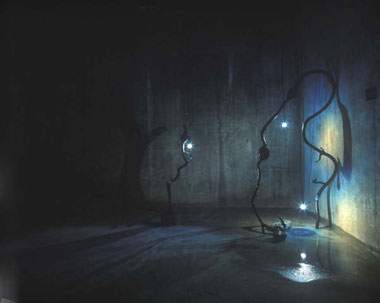 |
| Samantha McKee: Budding thoughts, 2005, installation shot; courtesy the artist |
The two venues, Golden Thread Gallery and Lagan Lookout Tunnel, have built up, over the last two years, a healthy reputation for bringing a young, gifted generation of artists to the attention of the Belfast public.
Slavka Sverakova
1 It is mentioned here to remind the reader, who might know Francis’ other paintings from the exhibition at the Kerlin Gallery, Dublin, November 2000 – January 2001. I am not suggesting that McKee saw his work. Her sources are outside art, in living organism and experiences with the medical profession.